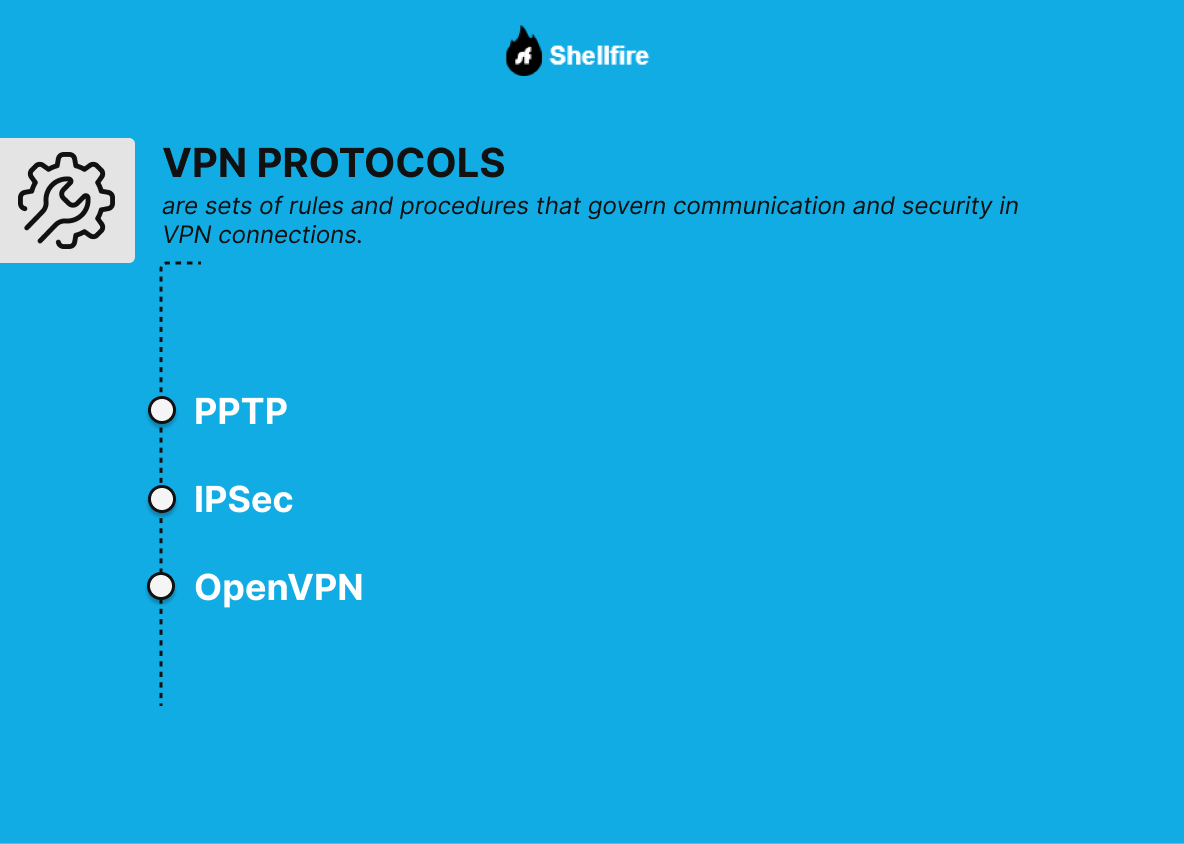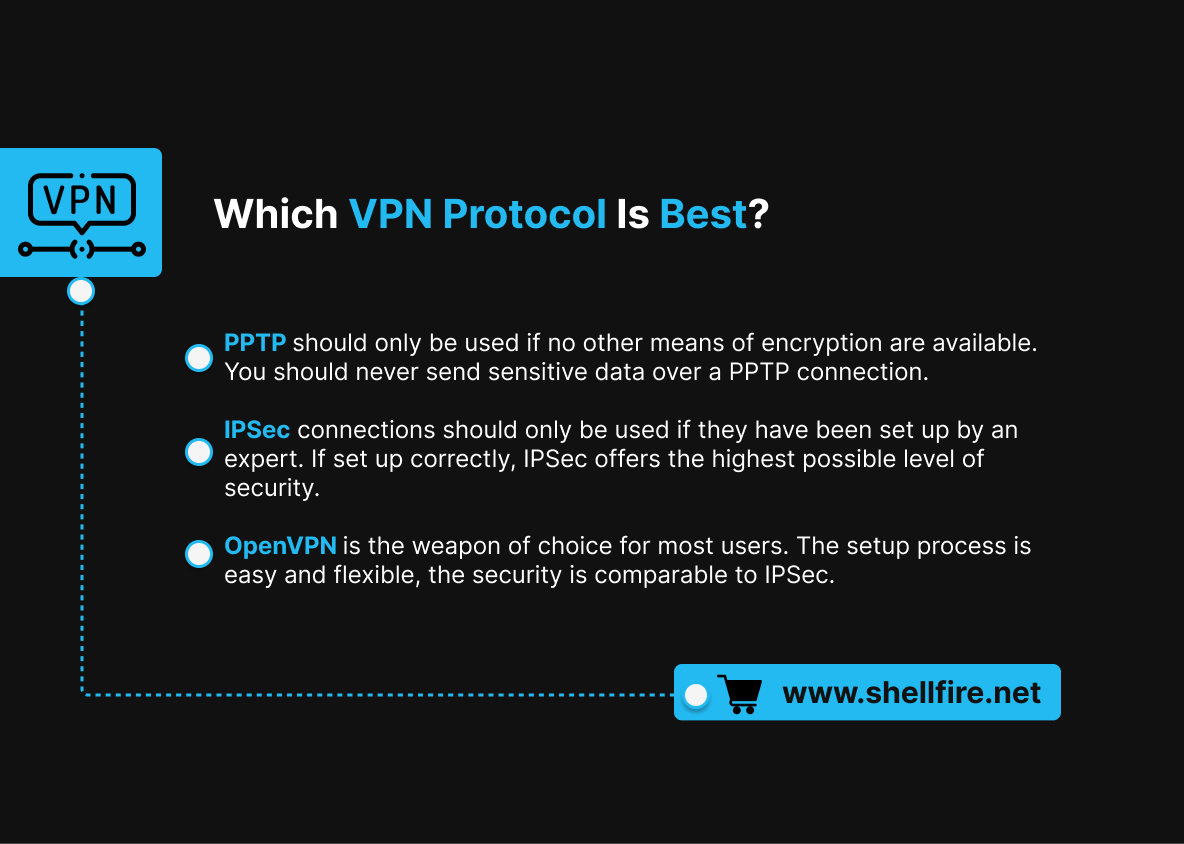PPTP vs. IPSec vs. OpenVPN – What are the differences?
If you’ve been diving into the world of virtual private networks, you’ve probably come across the trio of heavyweights: PPTP, IPSec, and OpenVPN. Questions about the differences between these protocols are like a daily special on our FAQ menu.
Well, fear not, because we’re here to untangle the VPN jargon for you in a way that won’t make your head spin. No rocket science, just the good stuff. So, buckle up, grab your coffee, and let’s break down PPTP vs. IPSec vs. OpenVPN without going all techno-babble on you. Let the showdown begin!
Table of Contents
Key facts
- PPTP, known as the “dinosaur” among VPN protocols, is user-friendly and widely available but suffers from significant security flaws.
- IPSec, encompassing various connection protocols, addresses PPTP’s weaknesses but introduces complexities in setup, potentially leading to unsafe configurations.
- OpenVPN is easy to set up, offers strong encryption, and provides excellent protection against man-in-the-middle attacks, making it a preferred choice for many users looking for a secure VPN connection.
VPN Protocols: What Are They?
VPN protocols, or Virtual Private Network protocols, are sets of rules and procedures that govern communication and encryption in secure VPN connections. These protocols facilitate the creation of secure tunnels over public networks, such as the Internet, allowing users to browse anonymously, unblock websites, and access content securely and remotely. Some of the most commonly used VPN protocols include:
- PPTP
- IPSec
- OpenVPN
With Shellfire VPN, you can switch between all three VPN protocols any time depending on your needs, whether you prioritize speed, security, or compatibility.

1. PPTP
Often referred to as the “dinosaur” of VPNs, PPTP has been widely integrated into operating systems for more than two decades due to its ease of setup. However, the aging protocol is plagued by vulnerabilities that compromise its security. Recent discoveries have exposed weaknesses in PPTP’s encryption, allowing hackers to decrypt encrypted data with relatively modest computing resources, which are now readily available through cloud services.
For organizations with formidable resources, such as the NSA or GCHQ, decrypting PPTP data is a minimal challenge. The protocol’s susceptibility to man-in-the-middle (MITM) attacks is a notable concern, as the lack of authentication for remote partners allows MITM scenarios to be set up seamlessly. In such attacks, all encrypted data transfer is exposed to potential interception.
Adding to the list of drawbacks, PPTP is often blocked by routers and firewalls by default in today’s environments, often unintentionally. This unintentional blocking, coupled with incompatibility with dual-stack lite (ds-lite) Internet connections, makes PPTP an increasingly impractical choice for users seeking secure and reliable VPN connections.
Advantages of PPTP
| Advantages of PPTP | Disadvantages of PPTP |
|---|---|
| Simple setup process | Vulnerable encryption |
| “Out of the box” support on nearly any operating system | Lack of protection against man-in-the-middle (MITM) attacks |
| No need for additional software installation | Limited compatibility with firewalls and routers |
| Susceptibility to being easily blocked by network providers |
Try Shellfire’s free VPN by clicking here!
Is PPTP still a good choice for fast VPN access?
While PPTP may offer high-speed connections due to its low encryption overhead, it comes at the cost of privacy and data security. For users focused solely on speed—such as accessing geo-blocked content with minimal protection—PPTP might be an option. However, for any activity involving personal data or sensitive information, modern VPN protocols like OpenVPN or WireGuard are far more reliable and secure.
2. IPSec
IPsec, which consists of a variety of connection protocols, is commonly paired with key exchange protocols such as IKEv1 or IKEv2, the latter also known as Cisco IPSec. Although the use of L2TP/IPSec has declined recently, IPSec remains a widely used and supported VPN security protocol. Similar to PPTP, IPsec is readily available “out of the box” in most modern operating systems, offering users the convenience of a built-in VPN solution.
While IPsec attempts to address the known weaknesses of PPTP, which performs adequately in most scenarios, its versatility in configuration introduces complexity that poses challenges for non-experts. This complexity can lead to the inadvertent creation of seemingly functional but ultimately insecure IPsec connections, particularly when users attempt manual configuration without understanding all technical aspects involved in VPN setup.
There are several considerations when using IPsec:
- Pre-shared key (PSK) authentication: The security of PSK authentication depends on the secrecy of the key. However, many commercial VPN providers issue identical PSKs to all customers, leaving them vulnerable to man-in-the-middle (MITM) attacks and compromising security. Certificate-based authentication is more secure but requires a more complex setup process. Unfortunately, many commercial VPN providers prioritize the simplicity of PSK authentication, reducing the overall security of the connection.
- Encryption Algorithms: IPsec supports a variety of encryption algorithms with different key lengths. However, not all of these algorithms are considered secure by current standards, so careful selection is required for optimal security. Users looking for a secure VPN connection must ensure their provider uses strong algorithms like AES-256 and modern hashing methods.
While IPsec is typically unobstructed by default firewall settings, users with ds-lite connections can use IPsec seamlessly. However, if a network provider or government, such as China, prohibits the use of IPsec, there is a risk of simple blocking. Understanding these nuances is critical for users who want both functionality and security in their VPN connections, especially when traveling or working remotely.
| Advantages of IPSec | Disadvantages of IPSec |
|---|---|
| Strong encryption (on correct setup!) | Complicated setup process |
| Good protection against MITM attacks (on correct setup!) | Danger of unsafe connections if not well configured |
| Usually no additional software required | Easily blocked by network providers |
For enhanced protection in your browsing, try Shellfire Box. Learn more about it here!
3. OpenVPN
As an open-source VPN protocol, OpenVPN is not supported by many operating systems by default. As a result, users typically need to install a dedicated software client to connect. Fortunately, configuration is generally straightforward, facilitated by commercial VPN vendors that offer downloadable configuration packages. These packages can be easily imported by the software client, streamlining the connection setup process for users of all technical levels.
The notable advantage of OpenVPN is its ease of use. The secure connection, strengthened by certificate-based authentication, can be established in seconds. Compared to IPSec, OpenVPN simplifies the setup of certificate-based authentication, which contributes to its widespread adoption by commercial VPN providers and, consequently, to its enhanced security and reliability.
However, there are a few considerations. Similar to IPSec, the security of OpenVPN’s pre-shared key (PSK) authentication depends on the confidentiality of the key. In particular, certificates offer a more secure alternative. Many users looking for high privacy levels choose OpenVPN because of this option.
OpenVPN is also notable for its flexibility. The connection can be configured to mimic regular HTTPS traffic, making it difficult for network providers to detect and block OpenVPN connections. This feature, combined with its ease of setup, firewall compatibility, and robust encryption standards, positions OpenVPN as the preferred choice for many commercial VPN users looking to bypass censorship or content restrictions safely.
Advantages of OpenVPN
| Advantages of OpenVPN | Disadvantages of OpenVPN |
|---|---|
| Easy setup | Additional software client required |
| Strong encryption | |
| Good protection against MITM attacks | |
| Very good firewall compatibility, difficult to block |
What is the most firewall-friendly VPN protocol?
OpenVPN is often considered the most firewall-friendly VPN protocol available today. Its ability to use port 443 and mimic HTTPS traffic allows it to bypass most firewalls and deep packet inspection techniques. This makes it an ideal solution for users facing network restrictions at schools, workplaces, or in countries with strict censorship laws.

Which VPN Protocol Is Best?
Choosing the best VPN protocol depends on specific user needs, preferences, and security considerations. In this context, OpenVPN is presented as the preferred choice for most users due to its user-friendly setup, robust security with certificate-based authentication, and flexibility in mimicking regular HTTPS traffic. It offers a compelling combination of ease of use, security features, and adaptability—ideal for both casual users and privacy-conscious individuals.
It’s important to note, however, that the “best” VPN protocol may vary based on individual requirements. For users who value simplicity, strong encryption, and flexibility, OpenVPN is a strong contender. On the other hand, IPSec, while more complex to set up, can provide the highest level of security when configured by an expert. PPTP may only be suitable in cases where speed is the only concern and security is not a priority.
Whether you’re trying to bypass censorship, protect your personal data on public Wi-Fi, or simply want a safer way to stream and browse online, selecting the right VPN protocol is crucial to achieving secure and stable performance.
Which VPN protocol is no longer considered secure?
The PPTP protocol could be considered insecure for several reasons, including:
- Weak encryption: PPTP uses 128-bit encryption, which was once considered strong but is now outdated. This level of encryption can be easily cracked by determined hackers and government surveillance agencies, compromising the privacy and security of user data.
- Authentication vulnerabilities: PPTP uses the outdated Microsoft Challenge Handshake Authentication Protocol (MS-CHAP) for authentication. This protocol has been found to be susceptible to cracking, allowing attackers to intercept and decrypt user credentials and gain unauthorized access to user connections.
- Weak defenses against attacks: PPTP lacks built-in integrity checks, making it vulnerable to common network attacks such as man-in-the-middle attacks. Attackers can tamper with or intercept transmitted data without detection, undermining the core principles of VPNs, which are to ensure data integrity and confidentiality.
Is OpenVPN suitable for streaming and torrenting?
Yes, OpenVPN is widely regarded as one of the best protocols for streaming and P2P file sharing. Its robust encryption ensures that your identity and data remain private while accessing geo-blocked content or downloading torrents. Additionally, its ability to bypass deep packet inspection and firewall restrictions makes it a powerful tool for users seeking unrestricted internet access.
Conclusion
In the complex landscape of VPN protocols, PPTP’s legacy as a “dinosaur” is marred by significant vulnerabilities and inadvertent blocking, making it a last-resort choice with explicit warnings against transmitting sensitive data. IPSec, a diverse family of connection protocols, attempts to fortify PPTP’s weaknesses, but introduces complexity, requires expert setup, and cautions against PSK authentication.
OpenVPN, however, emerges as the undisputed frontrunner, championing user-friendly setup, robust security with certificate-based authentication, and unparalleled flexibility in mimicking regular HTTPS traffic. Despite requiring an additional software client, OpenVPN’s resistance to blocking, compatibility with firewalls, and overall security make it the weapon of choice for users seeking both functionality and robust security in their VPN connections.
If you’re ready to enhance your online privacy, download Shellfire VPN today and take full control of your internet freedom.
Image: Freepik / Freepik

